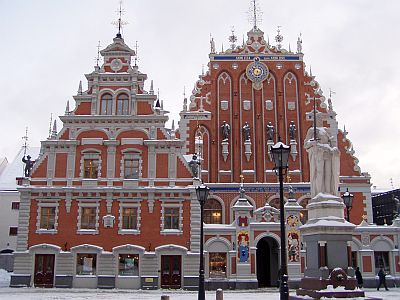History - a short overview
Latvians - or several tribes contributing to the nation of Latvians to be more precisely - probably settled only in the 9th century in present-day Latvia, but since they didn't form a nation, the Swedish soon knocked on their door. However, the area wasn't invaded for long and the tribes even remained pagan until the late 12th century when they were forcefully converted to Christians from Bremen (town in present-day Germany). In 1202, the Livonian Brothers of the Sword found together near Riga and gradually conquered the Baltic area. But the order lost the Battle of Saule against mighty →Lithuania, and so the Livonian Order as a branch of the Teutonic Order took over. This marked the beginning of German dominated Livonia, covering not only present-day Latvia but also large parts of present-day →Estonia during the 14th century. Throughout the centuries, Livonia had strong ties with the Hanseatic League.

| ||
| Typical Hanseatic league architecture: The Guild House of Blackheads (Riga) |
The Lutherian Reformation that started in Wittenberg / Germany reached Livonia already at the beginning of the 16th century, making most of its inhabitants Lutherians ever since. But in the middle of the 16th century, Livonian-Lithuanian War put an end to the Livonian nation. The country was divided, with the largest part belonging to Poland-Lithuania now and the northern territories being taken by Sweden and Denmark. Only the Duchy of Courland, covering what is now the western part of Latvia, remained more or less autonomous, which didn't change even when the Swedish invaded large parts of Livonia in 1629.
The Great Northern War from 1700 to 1721 didn't spare the Latvians. Same as Estonia, large parts of the area were given away to the Russian tsarist empire after the Treaty of Nystad. However, the tsar didn't bother to change things too much - the upper class still consisted of Germans only and the region remained a protestant stronghold. As a result of the first and third partition of Poland (see also →History of Poland), Courland and other areas became a part of the Russian empire. From 1816 to 1819, Russia abolished serfdom in its Baltic territories. During the 19th century, not much changed - except for some progress here and there and steadily growing Latvian nationalism as some sort of national revival, which became manifest in the annual Latvian Song Festival, first taking place 1873, and culturally very important ever since.
The First World War ravaged Europe soon after and reached Latvia in 1917 when Germany occupied the country. 1918 became even more dramatic when the Bolsheviki took over from defeated Germany. The Latvians saw their chance during the turmoil and declared independence on 18 Nov 1918. The Red Army didn't manage to hold the area and had to leave. The border was roughly drawn along linguistic isoglots - those areas in which the majority spoke Latvian became Latvian territory. The mostly German upper class remained in the country, but now Latvia was truly ruled by Latvians. In 1920, a peace treaty was sealed with the neighbouring Soviet Union in →Riga. Latvia developed quickly and experienced its heyday, but a coup in 1934 gradually turned the country into a dictatorship.
Starting around 1939, the small country eventually turned into one of many pawns in the struggle between Europe's super powers. The Soviets forced Latvia to allow the deployment of the Red Army. Due to the Secret Protocol of the Molotov-Ribbentrop Pact (aka Treaty of Nonaggression between Germany and the Union of Soviet Socialist Republics), Latvia was finally and "officially" annexed by the Soviet Union in 1940. Soon before, most Baltic Germans left the country at once - protected by a bilateral agreement. Stalin started his infamous reign of terror soon after that - countless Latvians were shot dead or deported during a first purge. Hence it was no surprise that many Latvians welcomed the advancing Wehrmacht in 1941. As a matter of fact, a substantial number of Latvians joined the German SS and collaborated in the annihilation of all Latvian Jews. Latvians formed their own units in the German Wehrmacht. But there was also a lot of resistance against the German occupation.
The Red Army came back in 1944 and again an estimated 100,000 or more Latvians were killed and many more deported. Now Latvia was assimilated as the Latvian Socialist Soviet Republic by the Soviet Union. The following decades saw a massive suppression of Latvian as a language and the local culture. Many Latvians used the postwar turmoil to leave the country - which is why there is a large Latvian diaspora.
Together with its neighbours →Lithuania and →Estonia, Latvia declared independence again in 1990, which was finally acknowledged by Moscow in 1991. After a turbulent start, Latvia soon managed to stabilize politically and economically. Together with 9 other countries, Latvia joined the European Union on 1 May 2004 - right after it joined the NATO.
©2024 Europe-East.com

 Albania
Albania Latvia
Latvia